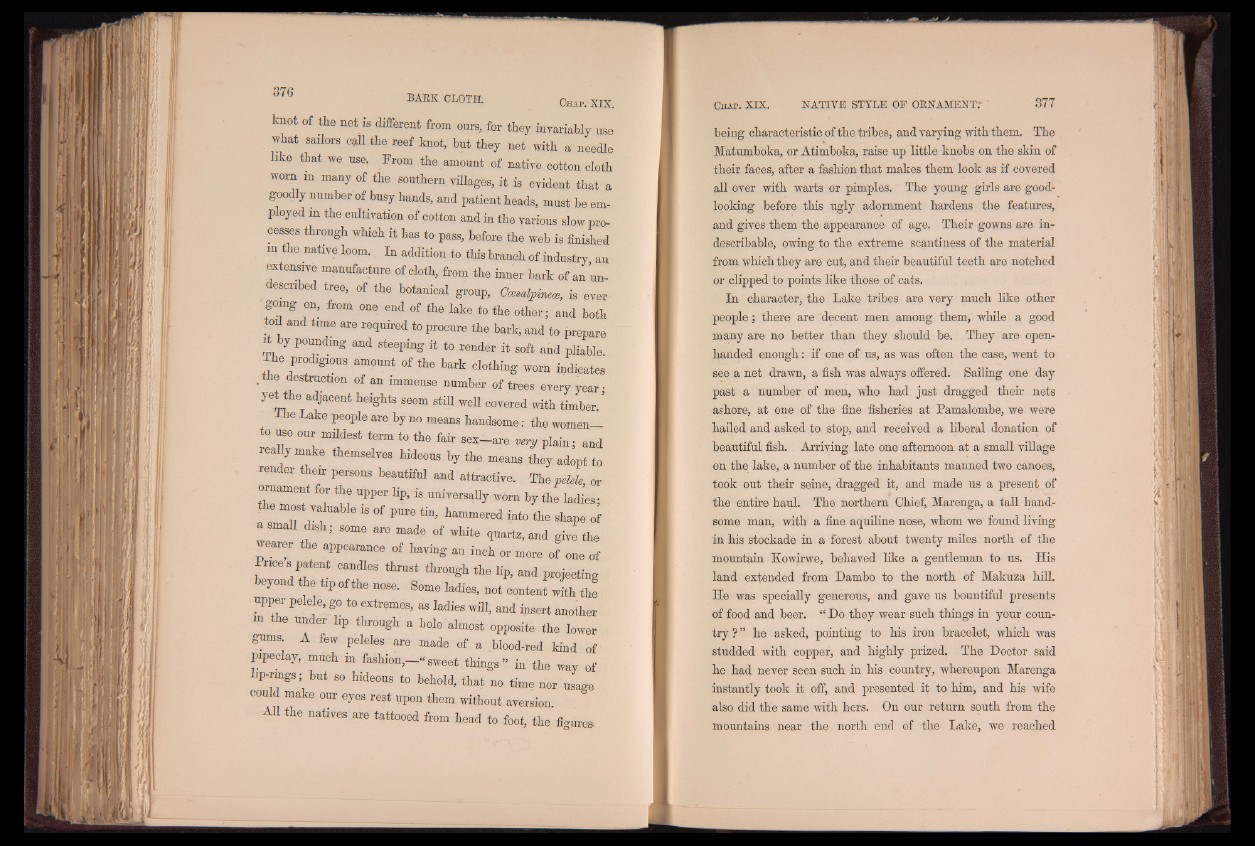
knot of the net is different from ours, for they invariably use
what sailors call the reef knot, but they net with a needle
like that we use. From the amount of native cotton cloth
worn in many of the southern villages, it is evident that a
goodly number of busy hands, and patient heads, must be employed
m the cultivation of cotton and in the various slow processes
through which it has to pass, before the web is finished
in the native loom. In addition to this branch of industry an
extensive manufacture of cloth, from the inner bark of an un-
described tree, of the botanical group, Ccemlpinece, is ever
going on, from one end of the lake to the other; and both
toil and time are required to procure the bark, and to prepare
it by pounding and steeping it to. render it soft and pliable.
The prodigious amount of the bark clothing worn indicates
. e destruction of an immense number of trees every year I
y e tth e adjacent heights seem still well covered with timber.’
Lake PeoPle are by no means handsome: the women—
to use our mildest term to the fair sex -a re very plain; and
rea% make themselves hideous by the means they adopt to
render their persons beautiful and attractive. Thepelele, or
ornament for the upper lip, is universally worn by the ladies;
the most valuable is of pure tin, hammered into the shape of
a small dish; some are made of white quartz, and give the
wearer the appearance of having an inch or more of one of
Prices patent candles thrust through the lip, and projecting
beyond the tip of the nose. Some ladies, not content with the
upper pelele, go to extremes, as ladies will, and insert another
m the under lip through a hole almost opposite the lower
gums A few peleles are made of a blood-red kind of
pipeclay, much in fashion,-« sweet things ” in the way of
lip-nngs; but so hideous to behold, that no time nor usage
could make our eyes rest upon them without aversion
All the natives are tattooed from head to foot, the figures
being characteristic of the tribes, and varying with them. The
Matumboka, or Atimboka, raise up little knobs on the skin of
their faces, after a fashion that makes them look as if covered
all over with warts or pimples. The young girls are good-
looking before this ugly adornment hardens the features,
and gives them the appearance of age. Their gowns are indescribable,
owing to the extreme scantiness of the material
from which they are cut, and their beautiful teeth are notched
or clipped to points like those of cats.
In character, the Lake tribes are very much like other
people; there are decent men among them, while a good
many are no better than they should be. They are open-
handed enough: if one of us, as was often the case, went to
see a net drawn, a fish was always offered. Sailing one day
past a number of men, who had just dragged their nets
ashore, at one of the fine fisheries at Pamalombe, we were
hailed and asked to stop, and received a liberal donation of
beautiful fish. Arriving late one afternoon at a small village
on the lake, a number of the inhabitants manned two canoes,
took out their seine, dragged it, and made us a present of
the entire haul. The northern Chief, Marenga, a tall handsome
man, with a fine aquiline nose, whom we found living
in his stockade in a forest about twenty miles north of the
mountain Kowirwe, behaved like a gentleman to us. His
land extended from Dambo to the north of Makuza hill.
He was specially generous, and gave us bountiful presents
of food and beer. “ Do they wear such things in your country
? ” he asked, pointing to his iron bracelet, which was
studded with copper, and highly prized. The Doctor said
he had never seen such in his country, whereupon Marenga
instantly took it off, and presented it to him, and his wife
also did the same with hers. On our return south from the
mountains near the north end of the Lake, we reached